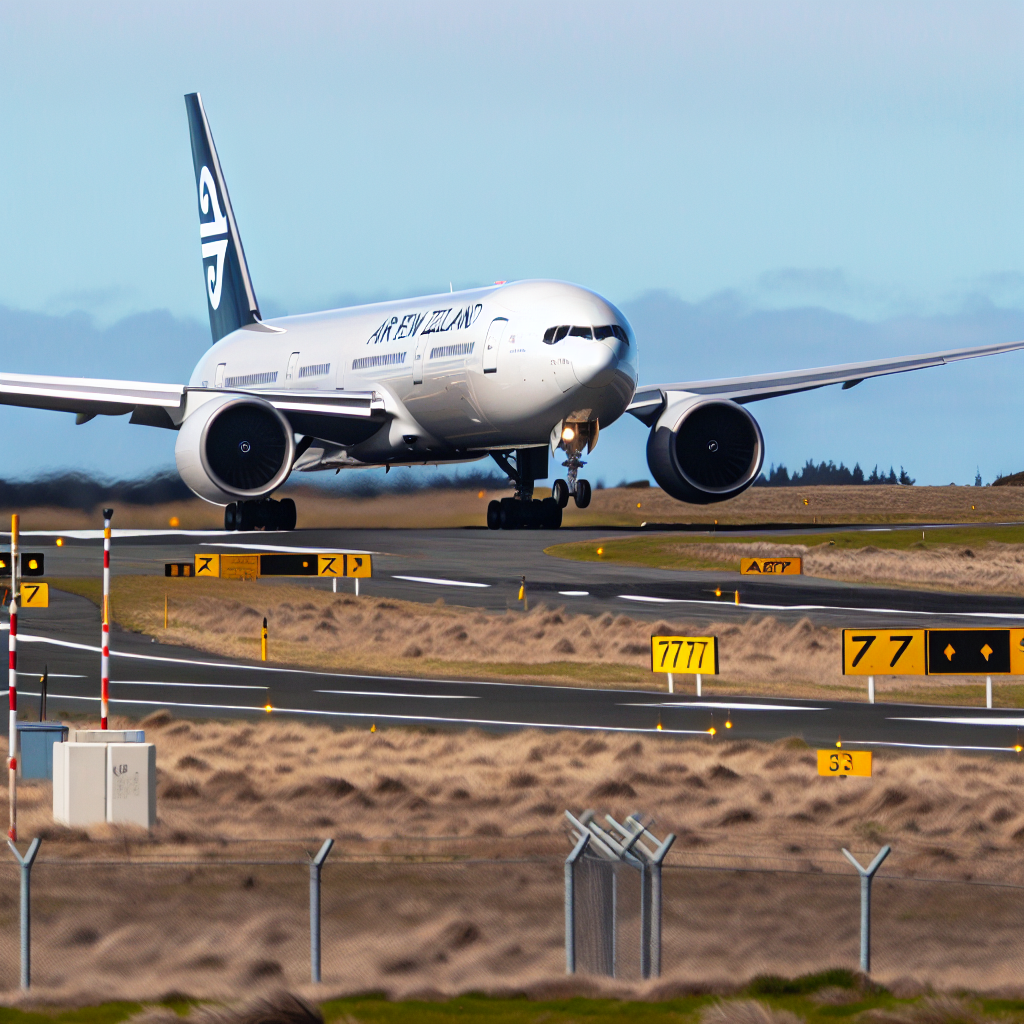AUCKLAND- The Transport Accident Investigation Commission of New Zealand has determined that a pilot error led to an incident involving an Air New Zealand (NZ) Boeing 777-300ER, which veered off the runway during its landing at Auckland International Airport (AKL). The aircraft struck several runway edge lights upon landing.
The investigative findings highlighted that the captain did not adequately adjust for the aircraft’s control response after disengaging the autopilot later than recommended during the approach phase.

The Air New Zealand (NZ) twinjet had departed from Melbourne (MEL) and was approaching Auckland (AKL) on January 27, 2023, with a total of 271 passengers and 16 crew members on board.
During its approach, the aircraft executed an ILS/DME approach to runway 05R under challenging weather conditions characterized by heavy rainfall and variable crosswinds.
The fluctuating crosswind during the approach added to the complexity of the landing maneuver.
The Boeing 777’s autopilot was engaged in runway-alignment mode throughout the approach, actively managing the crosswind effects to maintain alignment with the runway.
At 500 feet above ground level, the autopilot began applying corrective inputs to counter the left crosswind, ensuring that the aircraft remained on the centerline of the runway.
Despite the varying wind conditions, the autopilot successfully kept the aircraft aligned and maintained the target approach speed.
Timing Error
Standard operating procedures for Air New Zealand recommend disengaging the autopilot between 300 and 600 feet above ground level, allowing pilots ample time to establish manual control prior to commencing the landing flare.
In this instance, however, the captain deviated from the protocol by keeping the autopilot engaged until the aircraft was at just 67 feet above ground level.
By the time the captain disengaged the autopilot, the aircraft had already crossed the runway threshold.
The investigation timeline reveals a rushed sequence of actions following the autopilot disengagement.
Thrust lever reduction to idle power commenced just one second post-disengagement, and the landing flare initiated three seconds later, offering minimal time for the pilot to regain manual control of the aircraft.
Pilot Input Faults
The Transport Accident Investigation Commission highlighted a critical behavior of the autopilot system that contributed to the incident. Upon disengagement, the autopilot’s runway-alignment mode resets the flight controls to neutral positions.
Investigators stressed the importance of pilots maintaining the control inputs that the autopilot had been providing to remain on the intended flight path. Analysis of flight data indicated that the pilot did not maintain the left aileron input necessary to counter the crosswind.
Loss of Control
The failure to sustain proper control inputs resulted in the Boeing 777 rolling 3.69 degrees to the right and drifting off the runway centerline. The wind conditions shifted during this critical phase, with decreasing wind speed and a leftward shift in wind direction.
The investigation concluded that the pilot lacked sufficient time to effectively counter both the rightward roll and the changing crosswind conditions.
Damage Assessment
The aircraft made contact with the runway just 9 seconds after the autopilot was disengaged and subsequently veered off onto the sealed shoulder area.
In the process, the Boeing 777 impacted six runway edge lights before the crew managed to regain control and realign the aircraft with the runway.
The investigation determined that this runway excursion was “virtually certain” due to the sequence of actions, regardless of the runway surface conditions. Investigators noted that while the runway was wet from rain, there was no standing water that could have exacerbated the incident.
Safety Outcome and Aircraft Damage
Fortunately, all 271 passengers and 16 crew members onboard were uninjured during the runway excursion. However, the Boeing 777 experienced substantial damage to its landing gear.
Five out of six right main landing gear tires were damaged, with the rear inboard tire fully deflated.
Additional damage to the right brake assembly and wiring harness will require considerable maintenance before the aircraft is ready for service again.
Stay connected with us for further updates. For the latest information, follow us on social media.
Join us on Telegram Group to receive the latest aviation updates. Additionally, follow us on Google News.
Based on an article from aviationa2z.com: https://aviationa2z.com/index.php/2025/05/31/air-new-zealand-777-veered-off-the-runway-amid-pilot-error/?utm_source=rss&utm_medium=rss&utm_campaign=air-new-zealand-777-veered-off-the-runway-amid-pilot-error



